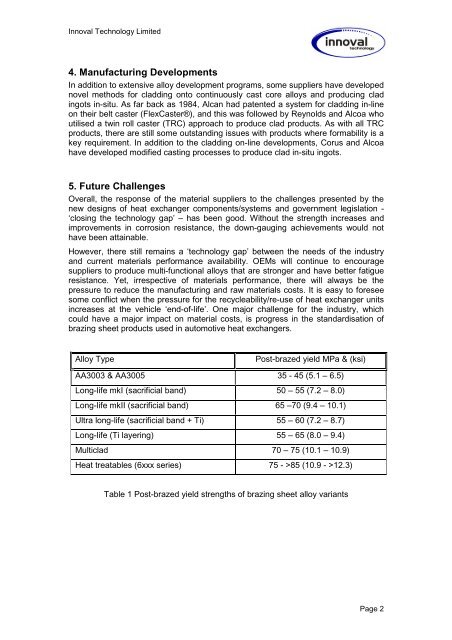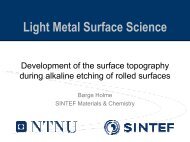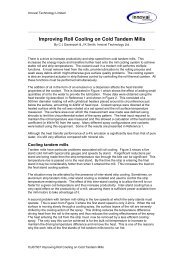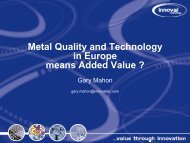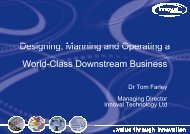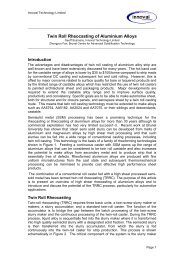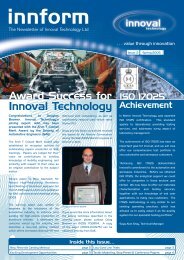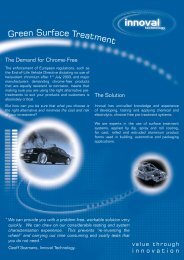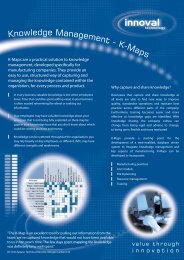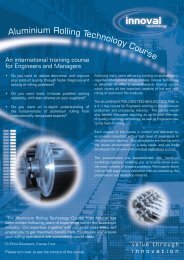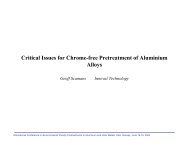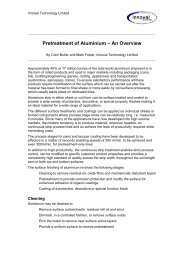The Growth of Aluminium in Automotive Heat Exchangers - Innoval ...
The Growth of Aluminium in Automotive Heat Exchangers - Innoval ...
The Growth of Aluminium in Automotive Heat Exchangers - Innoval ...
Create successful ePaper yourself
Turn your PDF publications into a flip-book with our unique Google optimized e-Paper software.
<strong>Innoval</strong> Technology Limited<br />
4. Manufactur<strong>in</strong>g Developments<br />
In addition to extensive alloy development programs, some suppliers have developed<br />
novel methods for cladd<strong>in</strong>g onto cont<strong>in</strong>uously cast core alloys and produc<strong>in</strong>g clad<br />
<strong>in</strong>gots <strong>in</strong>-situ. As far back as 1984, Alcan had patented a system for cladd<strong>in</strong>g <strong>in</strong>-l<strong>in</strong>e<br />
on their belt caster (FlexCaster®), and this was followed by Reynolds and Alcoa who<br />
utilised a tw<strong>in</strong> roll caster (TRC) approach to produce clad products. As with all TRC<br />
products, there are still some outstand<strong>in</strong>g issues with products where formability is a<br />
key requirement. In addition to the cladd<strong>in</strong>g on-l<strong>in</strong>e developments, Corus and Alcoa<br />
have developed modified cast<strong>in</strong>g processes to produce clad <strong>in</strong>-situ <strong>in</strong>gots.<br />
5. Future Challenges<br />
Overall, the response <strong>of</strong> the material suppliers to the challenges presented by the<br />
new designs <strong>of</strong> heat exchanger components/systems and government legislation -<br />
‘clos<strong>in</strong>g the technology gap’ – has been good. Without the strength <strong>in</strong>creases and<br />
improvements <strong>in</strong> corrosion resistance, the down-gaug<strong>in</strong>g achievements would not<br />
have been atta<strong>in</strong>able.<br />
However, there still rema<strong>in</strong>s a ‘technology gap’ between the needs <strong>of</strong> the <strong>in</strong>dustry<br />
and current materials performance availability. OEMs will cont<strong>in</strong>ue to encourage<br />
suppliers to produce multi-functional alloys that are stronger and have better fatigue<br />
resistance. Yet, irrespective <strong>of</strong> materials performance, there will always be the<br />
pressure to reduce the manufactur<strong>in</strong>g and raw materials costs. It is easy to foresee<br />
some conflict when the pressure for the recycleability/re-use <strong>of</strong> heat exchanger units<br />
<strong>in</strong>creases at the vehicle ‘end-<strong>of</strong>-life’. One major challenge for the <strong>in</strong>dustry, which<br />
could have a major impact on material costs, is progress <strong>in</strong> the standardisation <strong>of</strong><br />
braz<strong>in</strong>g sheet products used <strong>in</strong> automotive heat exchangers.<br />
Alloy Type<br />
Post-brazed yield MPa & (ksi)<br />
AA3003 & AA3005 35 - 45 (5.1 – 6.5)<br />
Long-life mkI (sacrificial band) 50 – 55 (7.2 – 8.0)<br />
Long-life mkII (sacrificial band) 65 –70 (9.4 – 10.1)<br />
Ultra long-life (sacrificial band + Ti) 55 – 60 (7.2 – 8.7)<br />
Long-life (Ti layer<strong>in</strong>g) 55 – 65 (8.0 – 9.4)<br />
Multiclad 70 – 75 (10.1 – 10.9)<br />
<strong>Heat</strong> treatables (6xxx series) 75 - >85 (10.9 - >12.3)<br />
Table 1 Post-brazed yield strengths <strong>of</strong> braz<strong>in</strong>g sheet alloy variants<br />
Page 2


